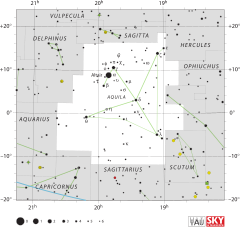Star in the constellation Aquila
Upsilon Aquilae , Latinized from υ Aquilae, is the Bayer designation for a star in the equatorial constellation of Aquila . With an apparent visual magnitude of +5.91[ 4] visible to the naked eye from suburban skies. It has an annual parallax shift of mas [ 1] light-years (54 parsecs ). The star is drifting closer with a radial velocity of –30 km/s.[ 5]
Upsilon Aquilae is a subgiant star with a stellar classification of A3 IV.[ 3] outer atmosphere is radiating energy into space with 10.5[ 6] Sun's luminosity from its photosphere at an effective temperature of 7,906 K,[ 2] A-type star . It is 180[ 8] projected rotational velocity of 42 km/s.[ 7]
References
^ a b c d e f Brown, A. G. A. ; et al. (Gaia collaboration) (August 2018). "Gaia Data Release 2: Summary of the contents and survey properties" . Astronomy & Astrophysics 616 . A1. arXiv :1804.09365 Bibcode :2018A&A...616A...1G doi :10.1051/0004-6361/201833051 Gaia DR2 record for this source at VizieR .^ a b c d e Soubiran, C.; et al. (June 2010), "The PASTEL catalogue of stellar parameters", Astronomy and Astrophysics , 515 : A111, arXiv :1004.1069 Bibcode :2010A&A...515A.111S , doi :10.1051/0004-6361/201014247 , S2CID 118362423 . ^ a b Cowley, A.; et al. (April 1969), "A study of the bright A stars. I. A catalogue of spectral classifications", Astronomical Journal , 74 : 375– 406, Bibcode :1969AJ.....74..375C , doi :10.1086/110819 . ^ a b c Johnson, H. L.; et al. (1966), "UBVRIJKL photometry of the bright stars", Communications of the Lunar and Planetary Laboratory , 4 (99): 99, Bibcode :1966CoLPL...4...99J . ^ a b Wilson, Ralph Elmer (1953), "General catalogue of stellar radial velocities", Washington , Carnegie Institution of Washington: 0, Bibcode :1953GCRV..C......0W . ^ a b c Anderson, E.; Francis, Ch. (2012), "XHIP: An extended hipparcos compilation", Astronomy Letters , 38 (5): 331, arXiv :1108.4971 Bibcode :2012AstL...38..331A , doi :10.1134/S1063773712050015 , S2CID 119257644 . ^ a b c Zorec, J.; Royer, F. (2012), "Rotational velocities of A-type stars. IV. Evolution of rotational velocities", Astronomy & Astrophysics , 537 : A120, arXiv :1201.2052 Bibcode :2012A&A...537A.120Z , doi :10.1051/0004-6361/201117691 , S2CID 55586789 . ^ a b De Rosa, R. J.; et al. (2014), "The VAST Survey - III. The multiplicity of A-type stars within 75 pc", Monthly Notices of the Royal Astronomical Society , 437 (2): 1216– 1240, arXiv :1311.7141 Bibcode :2014MNRAS.437.1216D , doi :10.1093/mnras/stt1932 ^ "* ups Aql" . SIMBAD Centre de données astronomiques de Strasbourg . Retrieved 2012-07-21 .
External links
